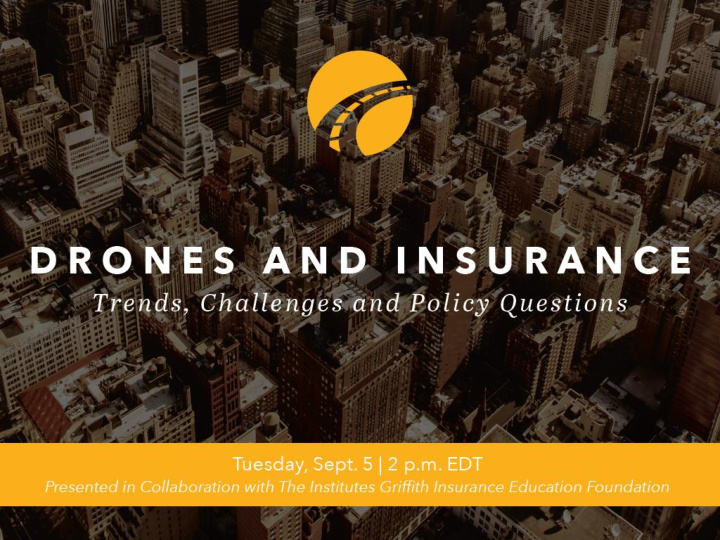



Drones and Insurance: Trends, Challenges, and Public Policy Questions
Kathleen McCullough Associate Dean Dr. William T. Hold/The National Alliance Program in Risk Management & Insurance College of Business Florida State University William Woodyard II, JD Chairman of the Faculty College of Business Florida State University
The Griffith Insurance Education Foundation, an affiliate of The Institutes, is a 501(c)(3) non-profit, non-partisan, and non-advocative educational organization dedicated to the teaching and study of insurance and risk management. In keeping with the non-partisan, non-advocative mission of The Griffith Foundation, we will keep our comments and contributions to today's program unbiased and purely educational.
Outline Overview of Drone Use – Trends and Key Risks Current Legal and Regulatory Environment – Overview of Current Legal and Regulatory Environment – Environment by Users Coming Challenges and Changes in the Legal and Regulatory Environment Insurance Issues and Trends Conclusions
Overview of Drone Use Drones or unmanned aircraft systems (UAS) • Rapid growth • Over 770,000 consumer drones registered with the FAA as of March 2017 FAA Aerospace Forecast Fiscal Years 2016-2036
Overview of Drone Use • Major economic impact • 100,000 new jobs by 2022 • Economic impact of $82 billion (Association for Unmanned Vehicle Systems, 2013) • Rapid innovation • Wide variation in use personally and commercially FAA Aerospace Forecast Fiscal Years 2016-2036
Overview of Drone Use • Major Risks – Safety – Privacy – Varying definitions – Changing legal and regulatory environment – Evolving insurance environment Photo: National Conference of State Legislatures, 2016
Current Legal and Regulatory Environment - Federal Key Sources • 2012 FAA Modernization Reform Act (FMRA) – Sections 331 and 336 • FAA Enforcement and Proposed Rulemaking – Requirements for non-recreational • Weigh under 55 pounds • Operate only during standard daylight hours and within visual sight • Must fly no higher than 500 feet and no faster than 100 mph • Operators must be at least 17 and pass the FAA knowledge test • Must be registered • Exemptions under Section 333 of FMRA From AUVSI Advocacy Website, 2017
Current Legal and Regulatory Environment - State From AUVSI Advocacy Website, 2017 – Includes Autonomous Vehicle Legislation
Current Legal and Regulatory Environment - State • Preemption • Variety of bills and resolutions in different states
Current Legal and Regulatory Environment - State Privacy • Government Operators (i.e. Warrant requirements) • Non-Government Operators • Related Federal Issues
Current Legal and Regulatory Environment - State Criminal penalties • Considerable variation in issues • Interfering with law enforcement or public safety • Recklessness • Flying near critical structures • Adding weapons or lasers • Unlawful surveillance
Environment for Hobbyists • Few regulations and laws • Safety guidelines and registration requirements • Potential criminal penalties for misuse • Insurance issues • Homeowners insurance • Association insurance
Environment for Commercial Users Exemptions by • Wide variety of legislation Business Size • Registration requirements • Exemptions • Large potential for profits however significant uncertainty in future regulation • Insurance • Variation in terms and definitions • New products From AUVSI Advocacy Website, 2017
Environment for Government Use • Limits on use with law enforcement • Safety concerns • Privacy concerns • Retention of information obtained with drones • Use of information obtained with drones Photo from https://www.linkedin.com/pulse/law- enforcement-use-drones-aerial-surveillance-jaevon
Challenges and Changes - Regulatory and Legislative • Defining drones as technology allows for smaller / stronger / faster drones • Integration with FAA and traditional aviation • Safety challenges as drone use increases • Evolving issues related to privacy and trespassing • Blurred lines between hobbyist use and commercial use • Balancing innovation and safety/privacy concerns
Challenges and Changes – Insurance Markets • Defining drones as technology allows for smaller / stronger / faster drones • The need for data and understanding of risks in rapidly evolving market • Understanding implications of rapidly changing rules, legislation, and regulation • Defining exposures beyond traditional property and liability • Blurred lines between hobbyist use and commercial use
Conclusions • Skyrocketing drone use is creating new risks and opportunities • Safety and privacy concerns drive many of the legislative questions • Like all emerging technologies the insurance industry is working to understand risk and develop appropriate coverage and pricing
Questions? Please submit them in the question box of the GoToWebinar taskbar.
Recommend
More recommend